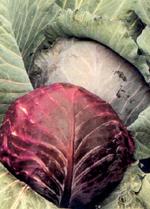| Fruits |
Vegetables
|
Red Cabbage, Brassica oleracea var. rubra / Cruciferae (Brassicaceae)
|
Note: Composition for 100 g. of fresh product Values in ( min. - max. ) format. | |
| Energy: 18.00-21.78 kcal Fats: 0.18-0.18 g Fibres: 2.50-2.50 g Minerals Calcium: 28.00-35.00 mgZinc: 0.239-0.239 mg Chlorine: 100.00-100.00 mg Phosporus: 28.00-30.00 mg Iron: 0.500-0.500 mg Magnesium: 18.00-18.00 mg Manganese: 0.100-0.100 mg Potasium: 266.00-266.00 mg Selenium: 0.920-0.920 µg Sodium: 4.00-4.00 mg Iodine: 5.20-5.20 µg | Proteins: 1.50-2.00 kcal Carbohidrates: 2.50-3.54 g Liposoluble Vitamins A Retinol: 2.50 µgA Carotenoids: 15.00 µg E or Tocoferol: 1.70-1.70 mg K or Filoquinone: 24.50 µg Liposoluble Vitamins B1 or Thiamine: 0.023-0.068 mgB2 or Riboflavine: 0.039-0.050 mg B3 or Niacine: 2.10-2.10 mg B5 or Pantothenic Acid: 0.320-0.320 mg B6 or Piridoxine: 0.150-0.150 mg B9 or Folic Acid: 50.00-150.00 mg C or Ascorbic Acid: 50.00-150.00 mg |

The red cabbage, also called purple cabbage, is an edible cabbage of a highly appreciated slightly sweet taste, characterized by the beautiful purple, magenta or dark purple colour of its leaves.
This variety is bred from the common cabbage cultivated all over Europe and found all the year round. It is cultivated, cooked and eaten as the rest of cabbages.
This variety is bred from the common cabbage cultivated all over Europe and found all the year round. It is cultivated, cooked and eaten as the rest of cabbages.
Nutrition and eating
The red cabbage is one of the vegetable varieties with greater content of selenium, which reduces the arterial pressure, supplies oxygen to the muscular tissue, produces antibodies, decontaminates from heavy metals, prevents sterility and activates the thyroids. The red cabbage is pectoral and it is recommended to treat tuberculosis and pleurisy.
The fruit
 The red cabbage (Brassica oleracea, var. capitata), also called purple cabbage, is an edible cabbage of a highly appreciated slightly sweet taste, characterized by the beautiful purple, magenta or dark purple colour of its leaves.
The red cabbage (Brassica oleracea, var. capitata), also called purple cabbage, is an edible cabbage of a highly appreciated slightly sweet taste, characterized by the beautiful purple, magenta or dark purple colour of its leaves. This variety is bred from the common cabbage cultivated all over Europe and found all the year round. It is cultivated, cooked and eaten as the rest of cabbages. The main difference is that red cabbages contain pigments of anthocyan responsible for the coloration that disappear during the baking, although they stay are maintained quite well in preserve.
The leaves are tightly arranged forming a headed cabbage, having a flat-topped, cylindrical, spherical or oval shape. They usually have even leaves, with a rounded shape and average size, intermediate to late precocity and are fresh or in stews.
It is normally cooked and becomes a very good ingredient in several dishes. The round varieties of intense colour are used for pickling. They can also be served slowly cooked in water, and optionally seasoned. In many countries, red cabbage is a traditional dish for Christmas. In Madrid, it has become one of the gastronomical symbols of Christmas, so its price raises during this period.
They are fundamentally made up of water although the vitamin and mineral content makes it a very nutritious vegetable. They have a very low caloric content (18-21,78 kcal for 100 g of fresh produce) reason why they are included in hypocaloric diets. It is eaten raw or in salads and means an important source of vitamin C for our organism.
The most suitable way to preserve them is in the fridge drawer, wrapped in a perforated plastic bag. They will last up to 2-3 weeks in perfect condition.
The plant
The plant belongs to the Cruciferae family (Brassicaceae). It belongs to the large species Brassica oleracea, to the group of the variety capitata. This plants bears a compact head of red leaves.
This plant bears flower spikes quite easily in cold weather, reason why the use of tunnels in early spring plantations is recommended.
This plant bears flower spikes quite easily in cold weather, reason why the use of tunnels in early spring plantations is recommended.
| Interempresas Media, S.L. / 2026 | [ Legal notice | Política de Protección de Datos | Política de cookies | Publicidad] |
